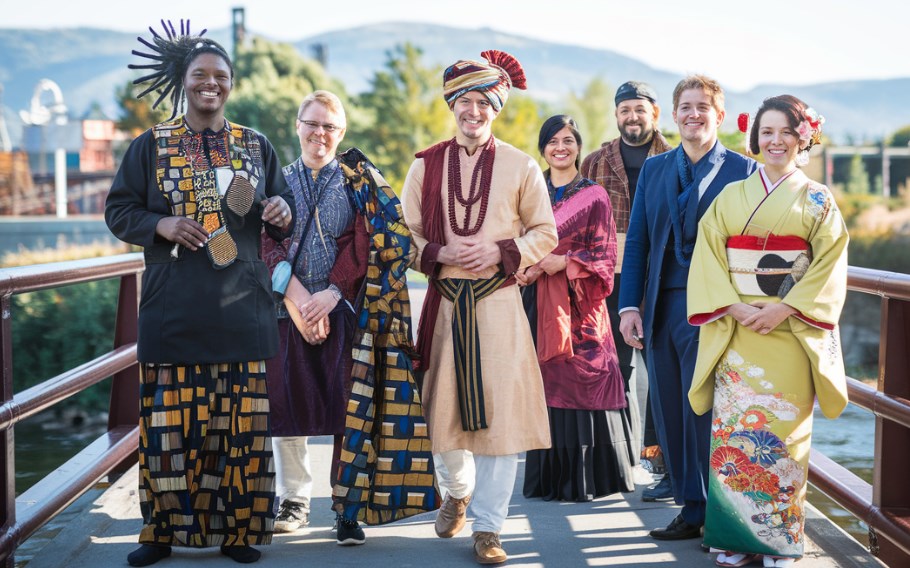Beyond Borders: Bridging Cultural Gaps Through Fashion
Ethnic fashion represents a rich tapestry of cultural heritage, encompassing traditional garments, patterns, and craftsmanship that tell the stories of diverse communities. As globalization blurs cultural boundaries, the importance of authentic representation in fashion becomes crucial. This article explores the historical context of ethnic fashion, its contemporary trends, and the challenges it faces, including issues of cultural appropriation and market accessibility. Our goal is to connect traditional and contemporary influences by showcasing groundbreaking designers and sustainable methods, cultivating an understanding of the importance and elegance of ethnic fashion in the modern, diverse world.
Tracing Roots
The historical background of ethnic fashion is profoundly intertwined with the traditions and customs of diverse cultures globally. For centuries, clothing has served to express identity, status, and community belonging, with each garment carrying significant cultural meaning. However, colonialism’s impact altered many traditional practices, leading to the commodification of ethnic styles and the dilution of their original significance.
In recent decades, globalization has facilitated cross-cultural exchanges, allowing ethnic fashion to gain visibility on the global stage. This blending of styles has created new opportunities for designers but raises concerns about the authenticity and preservation of cultural heritage. Understanding this historical background is essential to navigating the complexities of ethnic fashion today.
The New Wave
- Contemporary Designers: Emerging designers are reinterpreting ethnic fashion by incorporating traditional techniques into modern silhouettes. This fusion creates unique pieces that honor cultural heritage while appealing to contemporary tastes.
- Sustainable Practices: Ethnic fashion is increasingly focused on sustainability. Many brands prioritize eco-friendly materials, ethical production methods, and supporting local artisans, promoting a more responsible approach to fashion.
- Fusion Wear: The trend of fusion wear, which blends ethnic elements with Western styles, is gaining popularity. Outfits that combine traditional fabrics with modern cuts allow individuals to celebrate their cultural roots while fitting into everyday wear.
- Cultural Symbolism: Designers increasingly focus on the cultural significance behind patterns and textiles. Collections often highlight specific motifs, colors, and techniques that convey stories and meanings associated with particular communities.
- Digital Presence: Social media and e-commerce have transformed the way ethnic fashion is marketed and consumed. Online platforms allow designers to reach global audiences, showcasing their work through visually compelling campaigns and virtual fashion shows.
- Inclusivity: The push for inclusivity in fashion is reflected in ethnic collections that cater to diverse body types, age groups, and gender identities, fostering a sense of belonging and representation.
Digital Revolution
- E-commerce Growth: Online shopping platforms enable ethnic fashion brands to reach a wider audience, breaking geographical barriers and allowing consumers to access unique cultural pieces.
- Social Media Influence: Platforms like Instagram and TikTok play a crucial role in showcasing ethnic fashion. They allow designers to share their stories and connect directly with consumers, enhancing brand visibility.
- Digital Marketing: Targeted advertising and influencer partnerships on social media help promote ethnic fashion, attracting diverse audiences and driving sales.
- Virtual Fashion Shows: Technology facilitates virtual events, enabling designers to present their collections to global audiences without the constraints of traditional runway shows.
- Community Building: Online communities and forums create spaces for discussions around cultural heritage and ethnic fashion, fostering connections between designers, consumers, and cultural advocates.
Bridging Cultural Gaps
- Cultural Appropriation: The distinction between appreciation and appropriation can often become unclear, causing disputes when ethnic fashion elements are utilized without a full comprehension of their cultural significance, which can potentially disrespect the communities they originate from.
- Market Accessibility: Small designers and artisans face significant barriers in accessing mainstream markets, often struggling with limited resources and visibility compared to larger brands.
- Authenticity vs. Commercialization: As ethnic fashion gains popularity, there is a risk of dilution and commercialization, where traditional designs are altered for mass production, losing their original meaning and craftsmanship.
- Sustainability Concerns: Rapid production and consumption of ethnic-inspired clothing can lead to environmental degradation, making it challenging to maintain sustainable practices while meeting market demand.
- Lack of Representation: The underrepresentation of ethnic designers in fashion shows and media restricts their chances to showcase their creations and connect with broader audiences, which ultimately impacts their visibility and success.
Innovative Approaches
- Cross-Cultural Collaborations: Encouraging partnerships between designers from different cultural backgrounds can foster innovation and mutual respect, leading to unique collections celebrating diversity.
- Support for Local Artisans: Initiatives that prioritize purchasing from local artisans can promote traditional craftsmanship and empower communities economically, ensuring the preservation of cultural heritage.
- Educational Programs: Workshops and seminars that educate designers about cultural sensitivity and the importance of authenticity can promote ethical practices within the industry.
- Digital Platforms for Visibility: Utilizing social media and e-commerce can help ethnic designers reach global audiences, expand their market presence, and provide a platform for storytelling.
- Sustainable Fashion Initiatives: Emphasizing eco-friendly practices and materials in production can address environmental concerns while promoting ethnic fashion as a viable and responsible choice in the fashion industry.
Closing Thoughts
Bridging the gap ethnically requires a collective effort to respect and celebrate cultural heritage while adapting to contemporary trends. By fostering collaborations between designers, supporting local artisans, and emphasizing sustainable practices, the industry can honor traditional craftsmanship while appealing to modern consumers. The use of technology and social media is crucial in improving visibility and forming connections, leading to a fashion industry that is more inclusive and diverse. As we move forward, it is essential to approach ethnic fashion with sensitivity and appreciation, ensuring that it remains a vibrant expression of identity and cultural significance for generations to come.


